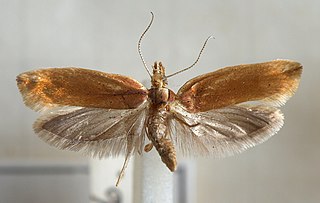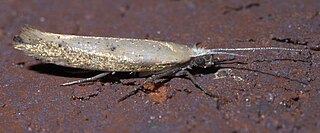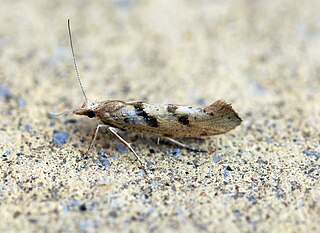Related Research Articles

Ypsolophidae is a family of moths with some 160 species. They are included in the Plutellidae by many authors.

Ypsolopha sequella is a moth of the family Ypsolophidae. It is found in Europe and Anatolia.

Ypsolopha dentella, the honeysuckle moth, is a moth of the family Ypsolophidae. It is found in Europe, Anatolia, north-eastern China, Russia and mideast Asia. It is also present in North America, where it is known from the eastern United States and southern Canada.

Ypsolopha scabrella, the wainscot hooktip or wainscot smudge, is a moth of the family Ypsolophidae. The species was first described by Carl Linnaeus in 1761. It is found in Europe, China, Russia, Asia Minor and mideast Asia.

Ypsolopha ustella, the variable ypsolopha moth, is a moth of the family Ypsolophidae. It is found in most of Europe and is also present in North America.

Agonopterix angelicella is a moth of the family Depressariidae. It is found in most of Europe, except the Iberian Peninsula and south-eastern Europe. It is also found on the Russian plain and Siberia and in Japan.

Ypsolopha canariella, the canary ypsolopha moth, is a moth of the family Ypsolophidae. The species was first described by Lord Walsingham in 1881. It is found throughout North America from sea level up to elevations of 1,830 meters. In Canada it occurs in most provinces, from British Columbia and Alberta to Ontario. It is present in most of the continental United States. It is known from a wide variety of habitats, including mixed wood forests, semi-arid scrubland, prairies and badlands.
Ypsolopha barberella is a moth of the family Ypsolophidae. It is known from the United States, including Arizona, Nevada and Utah.

Ypsolopha unicipunctella is a moth of the family Ypsolophidae. It is known from the United States, including Oklahoma, Texas and Arizona.
Ypsolopha striatella is a moth of the family Ypsolophidae. It is known from the United States, including California.
Ypsolopha delicatella is a moth of the family Ypsolophidae. It is known from the United States, including Arizona and California.
Ypsolopha cockerella is a moth of the family Ypsolophidae. It is known from the United States, including New Mexico.
Ypsolopha nella is a moth of the family Ypsolophidae. It is known from the United States, including Arizona and Utah.
Ypsolopha maculatella is a moth of the family Ypsolophidae. It is known from the United States, including Arizona and California.
Ypsolopha vintrella is a moth of the family Ypsolophidae. It is known from the United States, including Arizona and California.
Ypsolopha undulatella is a moth of the family Ypsolophidae. It is known from the United States, including Arizona, Utah and Colorado.

Ypsolopha sylvella is a moth of the family Ypsolophidae. It is found in most of Europe.

Ypsolopha falcella is a moth of the family Ypsolophidae. It is known from northern and central Europe and Russia.

Ypsolopha is a genus of moths of the family Ypsolophidae. It is the type genus of the family and comprises over 120 described species.
References
- ↑ nearctica Archived January 14, 2011, at the Wayback Machine
- ↑ Notes on the Cerostoma Group of Yponomeutidae, with Descriptions of New North American Species
 This article incorporates text from this source, which is in the public domain .
This article incorporates text from this source, which is in the public domain .